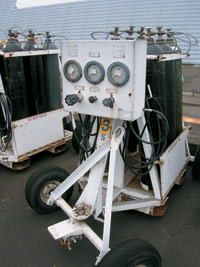
USING PORTABLE NITROGEN CARTS
Portable nitrogen carts (see fig. 4) are often used to service high-pressure equipment (such as accumulators) as well as low-pressure equipment (such as tires). To accommodate this range of equipment, nitrogen carts are typically equipped with both a high-pressure regulator and a low-pressure regulator.
INSPECTING WHEEL TIE BOLTS, NUTS, AND WASHERS
Because worn or damaged wheel tie bolts, nuts, or washers can cause (or contribute to) a dangerous wheel fracture, it is essential that operators and MROs place proper emphasis on inspection and replacement of this hardware. Each wheel Component Maintenance Manual (CMM) or overhaul manual provides specific inspection and rejection criteria for wheel tie bolts, nuts, and washers.
THE IMPORTANCE OF ONGOING TRAINING
Boeing recommends that operators and MROs train shop and maintenance personnel about the hazards associated with inflating wheel/tire assemblies. Boeing also recommends that operators and MROs place extra emphasis on wheel tie bolt, nut, and washer maintenance because this hardware can cause (or contribute to) dangerous wheel fracture.
SUMMARY
In the past 20 years, several accidents have occurred during tire servicing in which the wheel exploded because of over-pressurization, causing dismemberment or death to service personnel or damage to equipment. It is essential that tire-servicing equipment be equipped with a regulator to prevent tires from being subjected to excessive pressures that can result in an explosion. In addition, strict adherence to established procedures in the AMM and CMM will help ensure the safety of maintenance personnel during tire servicing. For more information, please contact Chris Dubuque at christopher.v.dubuque@boeing.com.


